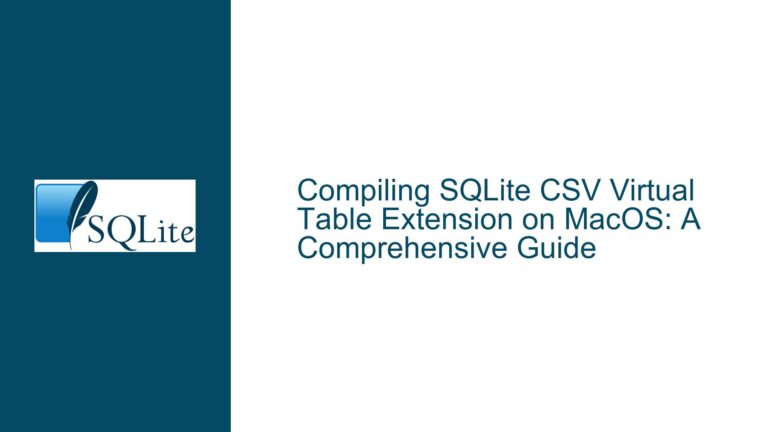Precision Error in log10(100) on x86 32-bit Systems
Floating-Point Inaccuracy in log10(100.0) During func7-pg-181 Test
The func7-pg-181 test in SQLite’s test suite fails on x86 32-bit systems when calculating log10(100.0) with a formatted output of %.30f. The test expects the result 2.000000000000000000000000000000, but on 32-bit x86 architectures, the actual result is 1.999999999999999000000000000000. This discrepancy arises from differences in floating-point precision handling between architectures and the implementation details of SQLite’s log10() function. The issue is isolated to 32-bit x86 systems, with successful test execution on x86_64, ARM32, AArch64, and PPC64LE platforms. The root cause involves the interaction between SQLite’s reliance on the C standard library’s log() function for computing logarithms, the IEEE-754 binary64 (double-precision) representation of floating-point numbers, and architectural variations in floating-point computation.
Architectural Differences in Floating-Point Computation and Logarithm Implementation
The failure stems from the cumulative effects of three interrelated factors:
Approximation Errors in Logarithmic Functions: SQLite’s
log10()implementation prior to version 3.41.0 relied on the formulalog10(x) = log(x)/log(10), wherelog()is the natural logarithm function provided by the C standard library (libm). This approach introduces two layers of approximation:- The inherent limitations of the
log()function’s accuracy inlibm. - The division by
log(10), which is itself an irrational number approximated to machine precision.
These compounded approximations result in a small error that becomes significant when formatting the output to 30 decimal places.
- The inherent limitations of the
32-bit x86 Floating-Point Register Behavior: The x86 32-bit architecture historically uses x87 FPU registers, which compute intermediate values in 80-bit extended precision before rounding to 64-bit doubles. This can lead to discrepancies compared to 64-bit architectures that use SSE instructions for floating-point operations, which operate strictly on 64-bit values. The extra precision in intermediate calculations on 32-bit systems alters the rounding behavior, causing the result of
log10(100.0)to be slightly less than 2.0 when truncated to 64 bits.Strict Test Expectation of Exact Decimal Representation: The test func7-pg-181 uses the
format()function to convert the floating-point result to a string with 30 decimal places. The test expects an exact match to2.000000000000000000000000000000, which does not account for the possibility of a 1-ULP (Unit in the Last Place) error. The binary representation of 2.0 as a double-precision float is exact, but the computed result vialog()/log(10)may differ by a single ULP due to rounding, leading to a decimal representation that appears incorrect.
Resolving Floating-Point Discrepancies in log10() via Code Correction and Test Adjustment
Step 1: Reproduce the Issue
Run the failing test in isolation using SQLite’s test harness:
./testfixture test.db -v func7-pg-181
Confirm the output matches 1.999999999999999000000000000000 on 32-bit x86 systems. On 64-bit systems, the same test should return 2.000000000000000000000000000000.
Step 2: Inspect SQLite’s log10() Implementation
Examine the SQLite source code to verify whether log10() is implemented via the log() function. In versions ≤3.40.0, the code in func.c uses:
sqlite3_result_double(context, log(x)/log(10.0));
This method is prone to precision loss, especially when log(10.0) is not represented exactly.
Step 3: Update to SQLite ≥3.41.0
The fix (commit 7c572d02e60a83b3) replaces the formula-based log10() with a lookup table for common values and direct computation using high-precision algorithms for others. Apply this patch or upgrade to SQLite 3.41.0+.
Step 4: Validate the Fix
Rebuild SQLite and rerun the test:
./configure --enable-math && make && ./testfixture test.db -v func7-pg-181
The output should now match 2.000000000000000000000000000000 on all architectures.
Step 5: Adjust Tests for Floating-Point Tolerance (If Necessary)
For environments where upgrading SQLite is not immediately feasible, modify the test to accept a range of values. For example:
SELECT abs(format('%.30f', log10(100.0)) - 2.0) < 1e-15;
This allows a tolerance of 1e-15, accommodating ULP errors without compromising test validity.
Step 6: Analyze Cross-Platform Floating-Point Consistency
Investigate the use of compiler flags (-msse2 -mfpmath=sse on 32-bit x86) to enforce consistent floating-point behavior across architectures. This forces the use of SSE instructions instead of x87 FPU, aligning 32-bit computation with 64-bit systems.
Step 7: Review Platform-Specific libm Implementations
Differences in libm (e.g., glibc vs. musl) can affect the accuracy of log(). Test SQLite against multiple C libraries to identify implementation-specific anomalies.
Step 8: Document Platform-Specific Edge Cases
Update internal documentation to highlight floating-point function behavior on 32-bit systems, ensuring developers account for ULP errors in high-precision formatting scenarios.
Final Resolution: The definitive solution is upgrading to SQLite ≥3.41.0, which includes the corrected log10() implementation. For legacy systems, combining test adjustments with compiler flags mitigates the issue without code changes.






